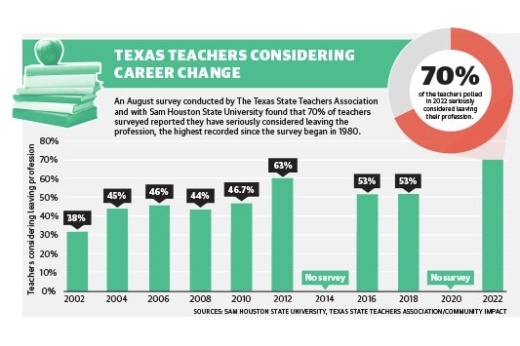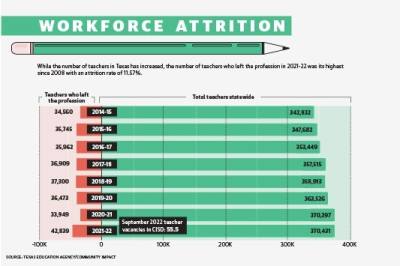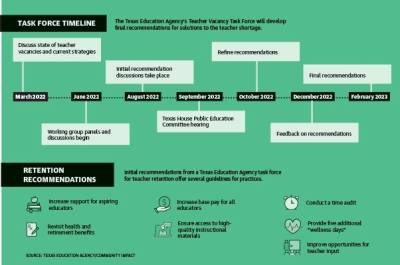An August survey conducted by the Texas State Teachers Association and Sam Houston State University indicated 70% of 688 teachers surveyed said they were considering leaving the profession following the 2021-22 school year. According to the TSTA, the number was the highest recorded in the survey’s 40 years and an increase of 17 percentage points from the last survey conducted in 2018.
At the beginning of the 2021-22 school year, the state saw an addition of 134 teachers to the workforce, Texas Education Agency data shows. In the 2020-21 school year, that number was 6,771. Meanwhile, the percentage of teachers statewide that left the profession in 2021-22 was 11.57%, compared to 9.34% the prior year—the highest percentage since the data was first tracked in 2008.
In the 2020-21 school year, the most recent available from the TEA, CISD’s teacher turnover rate—which measures the percentage of teachers who leave the district or move to another position—was 12.1%. In Montgomery and Willis ISDs, teacher turnover was 11.9% and 17.3%, respectively. Statewide teacher turnover for the year was 14.3%.
To address turnover locally, the three districts implemented pay increases and stipends for the 2022-23 academic year. Meanwhile, a statewide Teacher Vacancy Task Force created by the TEA is working on recommendations to increase teacher retention.
However, teachers and former educators said school districts are limited in the amount and type of incentives they can provide that are sufficient considering the stresses teachers face.
“I think the district is doing everything it can,” said Lisa Murray Kroger, a former CISD teacher. “I don’t think the district has much more they can do besides offer pay raises, but even at that they’re limited—they need more funding from the state.”
Addressing the shortage
Area school districts have increased pay for the 2022-23 school year as part of efforts to retain teachers. In April, CISD approved a $1,500 pay increase for teachers and a teacher starting salary of $60,000.
CISD Director of Communications Sarah Blakelock said the district aims to remain competitive and fairly compensate its employees.
“Conroe ISD is proud to be the largest employer in Montgomery County with over 10,000 employees including substitutes,” Blakelock said in an emailed statement. “To help attract qualified applicants, we increased the starting salary to $60,000 and offer a variety of stipends for select positions.”
In CISD, the district has seen more openings this year with over 50 teaching vacancies as of Aug. 26, higher than in previous years, Blakelock said.
“Many of the vacancies are due to our enrollment exceeding projections by over 900 students and the need for additional staff. Until all positions are filled, campus and district staff will cover any open positions as was done throughout the height of the pandemic,” Blakelock said.
In neighboring MISD, teacher salaries start at $56,200, and the district approved a $2,000 raise for teachers in April alongside a $1,000 incentive for employees who returned for the 2022-23 school year, according to previous reporting.
“We are also mindful of how we compensate our teachers, making it our top priority over the last two years in order to stay competitive with other districts,” Justin Marino, MISD assistant superintendent of communications and public relations, said in an email. “The disparity in public school funding that MISD receives compared to other districts across the state challenges our ability to attract, retain and grow high-quality educators.”
However, the district started the school year with zero teacher vacancies, Marino said, citing an emphasis on workplace culture and Montgomery’s reputation for being supportive of its educators.
WISD also offered a $1,000 incentive to returning full-time employees this fall and increased its starting salary to $55,000, according to the district.
Superintendent Tim Harkrider said in an interview WISD had eight open positions as of early October it was filling via a contract with K12 Elevate at Willis High School, a partnership that allows an online teacher to teach the course and a substitute to monitor students during the class time. Other positions were being filled by long-term substitutes.
“We definitely had more open positions this year than we had in the past,” Harkrider said. “It’s definitely a challenge in thinking outside the box.”
In March, Gov. Greg Abbott directed the TEA to form the Teacher Vacancy Task Force with the purpose of making recommendations to address the teacher shortage by March 2023. The group comprises teachers and administrators from districts all over the state. The task force meets every other month until February, when it will announce its final recommendations, according to the TEA website.
According to materials from its Aug. 25 meeting, the group discussed multiple avenues for increasing teacher retention and hiring, benefits, expanding access to high-quality instructional materials and conducting a time audit. The task force could not be reached for comment through its website before press time.
Jamie Puente, public policy analyst with Every Texan, an Austin-based public policy organization, said these issues of funding and salaries are central to teachers’ concerns.
“Colleagues who represent teachers are all saying ... they want to leave; they want to get out of the profession. They feel the teaching profession has been under attack for years from being underfunded, [and] they don’t get paid nearly enough,” Puente said.
State support
CISD teacher Tim Fox said he believes the teacher shortage has been a long time coming.
“We haven’t done anything to change this,” Fox said. “That’s my biggest problem—our representatives are doing nothing for teachers.”
State Sen. Brandon Creighton, R-Conroe, said in an email statement that recruiting, supporting and retaining classroom teachers is one of his priorities, including creating a “Teacher Bill of Rights” to give teachers more of a voice in their schools and districts.
He said he believes the state is committed to funding and hiring new teachers.
“If you keep hearing about the teacher shortage, it is because Texas is funding new positions at a record pace,” Creighton said. “This year represents the most teachers ever hired in the state of Texas.”
According to TEA data, Texas saw 42,973 new teacher hires in 2021-22, an increase of 11.6% from the previous year and the highest number of any academic year tracked by the TEA beginning in 2007-08.
However, the TSTA/SHSU survey also showed 94% of teachers surveyed reported stress in their professional lives had increased, and 41% said they had to take an extra job during the school year.
Of those with second jobs in the survey, 87% said they would quit their side job but would need a $12,000 salary increase.
Statewide, many teachers said districts have not had sufficient resources despite efforts at the state level.
“The governor has called for this task force on the teacher shortage, but it doesn’t take a task force to figure this out. More funding, fewer political attacks on teachers, let the teachers teach,” TSTA spokesperson Clay Robison said. “Districts are limited to what they can do.”
Harkrider said WISD is focusing this year on providing support for its teachers in their first three years with instructional coaches and check-ins from administrators to help teachers with the stress of the profession.
“We have more employees over the last three years that will just quit during the school year. My first seven years here, that might have happened one or two times, ... but now it’s become unfortunately very common across the country,” he said.
House Bill 3 was passed in 2019 to increase funding for public education, according to the TEA.
However, CISD Chief Financial Officer Darrin Rice said the percentage of state funding to the district has decreased overall since the implementation of HB 3.
Based on preliminary 2023-24 numbers, Rice said the district is looking at a budget shortfall of around $12 million or more.
“We’re growing at such a rapid rate now. ... There is no mechanism in the state funding formula to provide our employees with raises,” Rice said.
Teaching roadblocks
Education advocacy groups noted changes to statewide curriculum standards and other issues such as school safety are also considerations for teachers leaving the profession.
“They are dealing with high-stakes testing; they’re dealing with all of these other systemic issues,” Puente said.
In addition, a 2022 study of problems in the teaching profession conducted by the Charles Butt Foundation showed noninstructional tasks are becoming increasingly burdensome: 86% of teachers reported too many noninstructional tasks and responsibilities as a barrier to good teaching.
State Rep. Steve Toth, R-The Woodlands, said he believes quality of life and discipline are two issues driving teachers from the classroom.
“Between classroom preparation, teaching time and reporting time, teachers face upwards of 60 to 70 work hours per week,” Toth said in an email. “There’s no quality of life with that kind of workload.”
For some teachers, the changes have not come soon enough. This year, Kroger allowed her teaching certificate to lapse.
“It was a really, really hard decision for me because I do miss it,” she said. “I miss the kids. I miss those relationships. I miss, you know, the bonds that you form, ... but I just can’t go back.”
Wesley Gardner contributed to this report.








